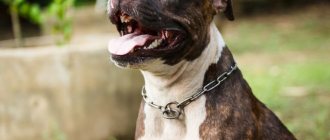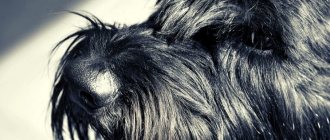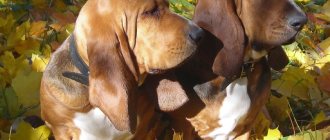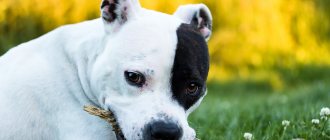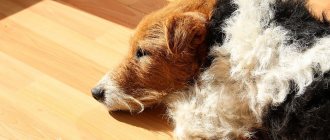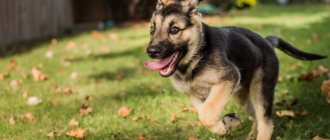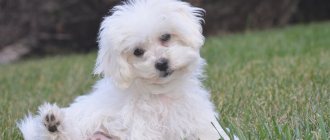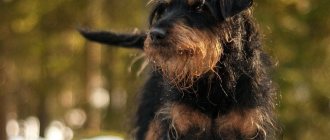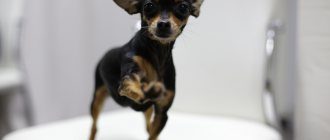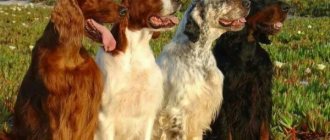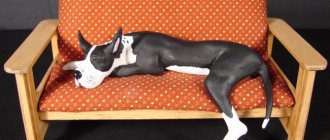09/30/2019 Irina Malinina 0 comments
The Scottish Setter, better known as the Gordon Setter, is a pointing gun dog. This beautiful animal with a proud posture and simply royal appearance fully reveals its advantages during the hunt. But even in everyday life, this dog will become an excellent companion, because it stands out for its calmness and friendliness and rarely expresses its dissatisfaction.
Setters are used very often in search and rescue teams. After all, dogs are distinguished by well-developed sense of smell, intelligence and intelligence.
History of the origin of the breed
It is believed that the ancestors of the Scottish Setter are spaniels. Selection of this breed was carried out in various directions, so there were many subspecies: for hunting in wetlands, on the plain, setting spaniels, which have a completely unique hunting method. The tallest and largest individuals were crossed with similar breeds in order to strengthen their hunting qualities.
At the beginning of the 9th century, hunters Thomas Cloke and Henry Paget paid attention to this particular subspecies, using black setters with tan marks as a basis. Subsequently, several such individuals ended up in the possession of Duke Alexander Gordon. The representative of the aristocracy liked their appearance so much that he began breeding the breed, focusing on improving hunting and guarding qualities, preserving and improving the exterior.
For these purposes, crossbreeding was carried out with Irish setters, pointers, shepherd dogs, hounds and bloodhounds, which gave the famous tan color.
Subsequently, the selection was continued by Gordon’s son, Georg. As a result, it was possible to develop a completely new type of hunting dog with a set of unique qualities, which in its name bears the prefix in honor of the breeder - the Gordon Setter. The breed was finally formed by 1860.
Photo: wikimedia.org
Hunting with Gordon
Gordons are considered the best assistants for novice hunters. With highly developed search instincts, “Scots” are much more balanced than their relatives in the section, and therefore easier to manage. When hunting, the breed does not go far from humans, is ready to work in any weather and is practically tireless, which is valuable when working with swamp, forest and steppe game. The black and tan setter works with its upper senses, making a distinct, if not picturesque, stance when detecting prey. Some individuals are capable of aerobatics - freezing in a stance, periodically looking back at the hunter, inviting him with a look to join the process.
Description of the breed
Among the setters, Gordons have the most impressive size, which affects their strength and endurance. They have versatility - they can hunt in any conditions, quickly adapting to changes that may occur while tracking prey.
However, these same physical indicators affect the speed of movement of setters, forcing them to be inferior to other pointers in this indicator.
The breed standards are:
- the height at the withers for males is 60-70 cm, for females 60-67 cm. This is a very important indicator for this breed, so any deviations from the standard indicators will lead to the disqualification of the individual;
- the weight of males often reaches above 30 kg, females are lighter - from 25 to 30 kg; a dog of this breed has very developed muscles with strong bones;
- limbs are developed, long and very dexterous;
- the small head is located on a long graceful neck;
- the tail is strong, quite thick at the base, but tapers towards the end;
- a large number of olfactory receptors are located on the neat elongated muzzle, which allows the Scottish Setter to hunt in the most false conditions;
- ears are triangular, hanging;
- the breed belongs to the smooth-haired category;
- The only acceptable primary color of a Gordon is black. A rusty tint is not allowed; the transition to scorch marks must be clear. The location of the markings is strictly regulated by the breed standard and any deviation leads to disqualification. The presence of white spots is unacceptable;
- eyes are round or somewhat almond-shaped, eye color is brown;
- Gordon Setters live on average from 12 to 16 years.
Photo: wikimedia.org
Characteristic
Scottish Setters are suitable for hunting. They are large in size, which is why they are the most durable, but their size affects their speed. Therefore, they run a little slower than cops.
This breed of dog can hunt in any terrain, and in the event of a sudden change in the situation, they act in the right direction.
Note!
Nicknames for dogs for boys - easy, rare and most beautiful names for dogs in alphabetical order
Nicknames for girls' dogs - a list of beautiful, funny, unusual nicknames for large and small dog breeds
Maltipoo dog - everything about the dog from A to Z. Photos, description of the breed, character, maintenance features, prices, reviews
Character and behavioral characteristics
Setters are particularly devoted to their owner, as they are his constant companions in life.
This hunting dog has a very stable psyche and developed intelligence. Feels great in the company of other animals, but has a desire to lead and achieves this by suppressing competitors with force. A well-mannered animal will never harm small domestic animals, since they are trained not to touch prey when hunting.
The family recognizes one of the family members as the leader, but this does not mean that the rest will lose the dog's respect. The noble representatives of this breed get along well with children.
In addition to hunting, the Scottish Setter will do an excellent job of guarding its owners, but you cannot buy a Scotsman only for the purpose of protecting the house.
Photo: wikimedia.org
Buying puppies
Any owner of this breed, when asked where to buy a Scottish Setter, will answer you that you can only buy it in a very good nursery or from a breeder who is a professional in this and has a huge reputation.
The price of a small Scottish Setter puppy starts from approximately 36,000 thousand rubles.
Education and training
Even if hunting is not the main hobby of the future owner of the setter, he will have to constantly tax the pet physically. Training should begin as early as possible, gradually making the commands more complex.
Setters are completely unique hunters who track prey by scent, then signal this to their owner by taking a stance. Next, after receiving the command, they flush the bird and crouch to the ground so that the hunter can shoot, but not hit them.
The upbringing of a setter occurs simultaneously with training. The training process is very important and requires the participation of a qualified specialist.
Only a purebred dog with a pedigree can participate in the hunt. Such animals must undergo training, field testing and be registered with the hunting industry.
Photo: wikimedia.org
Conditions for keeping
Let's start with the most important thing - no chains or closed small enclosures. Setters love freedom and need space to feel well and be sufficiently active.
If you plan to keep your dog in a fenced area, then it should be free-standing, and it is better to lay the perimeter with tiles or concrete so that the pet cannot dig under the ground. You don’t have to own a private country house to get such a dog. Gordons are perfectly suited to living in an apartment. The main thing is that the animal has the opportunity to be active. This means not only walking, but also the availability of free space in the apartment.
Activity should be given special attention; this is one of the main conditions for a good quality of life for such dogs. At least once a week you should have the chance to travel out of town or walk the dog in a large park
You can combine walking your animal and your own exercise, such as jogging or cycling, scootering or skateboarding. Daily distances of 3 to 10 kilometers with gradually increasing distances will be an excellent way to walk.
Another feature of the content is the wool. It is quite long and will require washing, frequent combing and trimming. Learn to do this yourself or find a master in advance with whom the dog and you can arrange further work. If you get a show dog, one of the main rules is that the show participant should not live on the street. Due to weather conditions, the constitution of the dog’s coat will change, that is, an undercoat will appear, and this will affect its appearance.
You should comb your pet with a wide-toothed comb. To prevent the formation of tufts and clumps of matted fur, the frequency of combing should not be less than once every 2 days. Don't overdo it with bathing. It is recommended to wash ordinary dogs once every 30 days, and show dogs - once every 7-10 days. In no case should you forget about special care shampoos and balms, so as not to dry out the skin due to frequent washing. And also don’t forget about care oils. Which ones to choose – ask your breeder, trainer or veterinarian.
In addition to the coat, it is important to take care of the teeth and ears. It is recommended to clean at least once a week
Pay attention to your eyes and remove formations in a timely manner. Nails also need care
If you do not trim them in a timely manner, your pet will get tired of walking faster, and the risk of injury during training and at home will increase. In 3-4 weeks, the claws will grow and will need correction, keep this in mind.
Diseases and care
Gordons are particularly resilient, they have strong immunity and rarely get sick. However, they have diseases that are hereditary:
- retinal atrophy, which is progressive;
- joint dysplasia;
- volvulus of the intestines or stomach;
- otitis;
- cataract;
- hepatitis.
The breed is prone to parasitic infestation due to its constant exposure to nature, often in wetlands. Particular attention should be paid to treatment against ticks.
Setters do not require special care. A clear plan for caring for them is required, which includes all routine vaccinations, treatment for all types of parasites and preventive visits to the veterinarian.
The Scots coat needs daily combing and periodic trimming (either on your own or in a salon). Because Setters have drooping ears, more frequent inspection and grooming is required.
The dog is suitable for apartment living, but will be absolutely happy only in close proximity to nature - outside the city. The owner must provide long walks with active physical activity.
Before the start of the hunting period, the dog must be additionally prepared by changing its diet.
Health
The average life expectancy of a Scottish Setter is 12-13 years.
Gordon was blessed with good health by nature. To maintain it, the owner must annually bring the pet to the veterinary clinic for tests, x-ray examinations and preventive examinations.
It is important to get vaccinated on time and treat with medications against skin parasites, especially in the spring and summer. Don't forget about deworming.
Although the Scottish Setter is little susceptible to disease, a predisposition to some health problems is still observed. The list below outlines a number of diseases to which the Gordon Setter is prone:
- Progressive retinal atrophy - if left untreated, leads to partial or complete loss of vision.
- Dysplasia of the hip and elbow joint - in the first stage there is lameness, tolerable pain, in the last stage there is unbearable pain and immobility.
- Hepatitis is infectious and toxic, difficult to treat and often fatal.
- Laryngeal spasms are the absence or insufficient tone of the laryngeal muscles.
- Gastrointestinal diseases.
Feeding
The peculiarity of the breed is a very moderate appetite, so the owner will have to very strictly monitor the diet, including all the necessary vitamins and minerals.
You should choose premium dry food that is designed specifically for active dogs.
For harmonious development, the puppy begins to be fed natural food, which usually contains lean meat and offal. From 6 months it is possible to switch to ready-made food.
The setter's diet should include a large amount of lean meat (chicken or beef) and vegetables. Cereals are necessary in the diet, but not more than half the daily portion.
The breed has an increased need for water.
Photo: flickr.com
Choosing a nickname
The Scottish Setter is a dog with an aristocratic and elegant appearance. Simple names are not suitable for such a dog; it is better to choose a beautiful English nickname. A clue may be the name listed in the pedigree.
Unfortunately, the Scottish Setter breed is not a leader in popularity. The noble appearance and friendly disposition of these dogs allows us to conclude that this is completely undeserved. For an energetic owner, such a pet will be an excellent walking companion and a loyal friend.
Photo
Photo: wikimedia.org
Photo: flickr.com
Photo: wikimedia.org
Photo: wikimedia.org
Mating
Dogs are knitted when they are fully formed. Although puberty begins early (at 10-12 months), it is recommended to breed only at 2-3 years. The female will be physically and mentally ready to bear and give birth to puppies. During the third or quadruple heat (the most favorable period), symptoms of readiness will appear: a loose loop, light discharge, a playful mood.
Mating through the nursery is carried out for breeding individuals. The owners set a mating date, fill out forms and receive a certificate. The cost of mating depends on the wishes of the owner of the dog. Usually it is equal to 1 puppy.
On the appointed day, the girl is brought to the territory of the male dog. It is best to walk your pets together so they can socialize. Then the boy will mount if the female allows him. For the first time, it is better to invite a specialist who will help the owners understand the process.
After several active movements, the animals will freeze and stand in a castle. This state will last 15-20 minutes . It is important not to let the bitch sit down, but to hold the dog by the croup. If there was no lock, then the girl may be pregnant. Mating is repeated after 2 days . The course of pregnancy is monitored at a veterinary clinic.
Read a detailed article on the topic: “Everything you need to know about breeding dogs: appropriate age, what to do if it doesn’t work out, rules and tips.”

